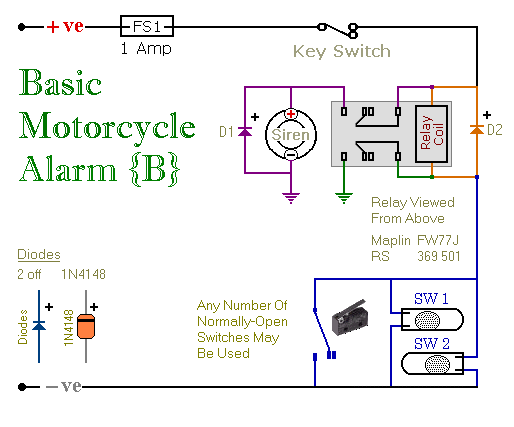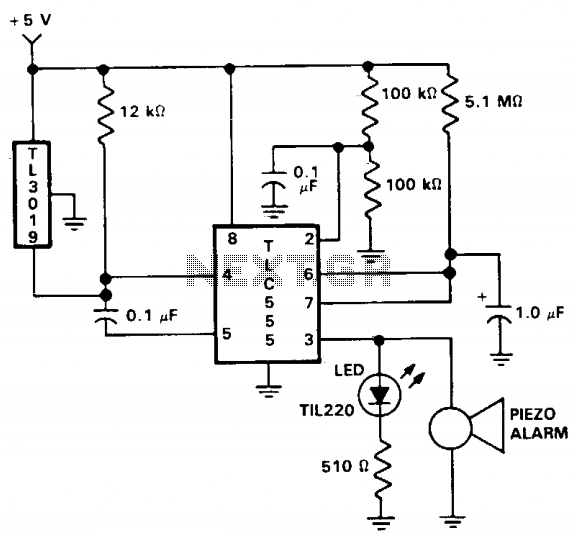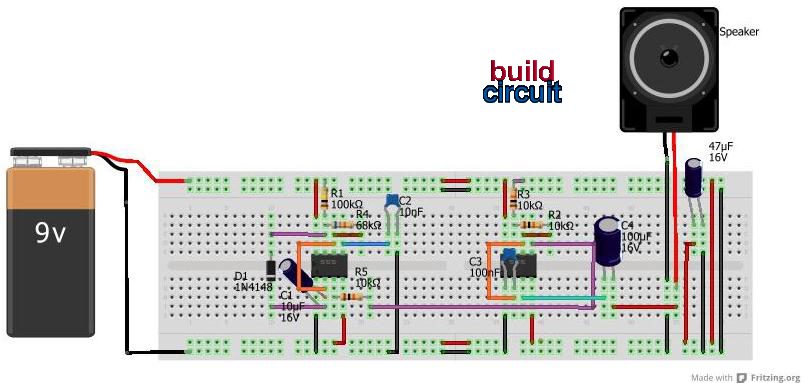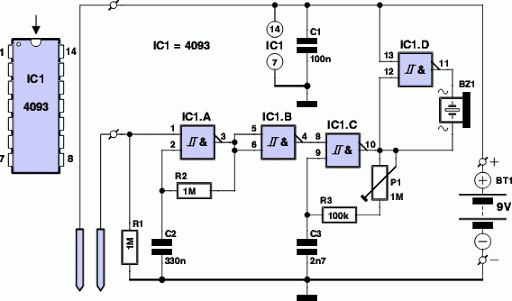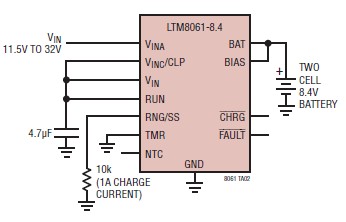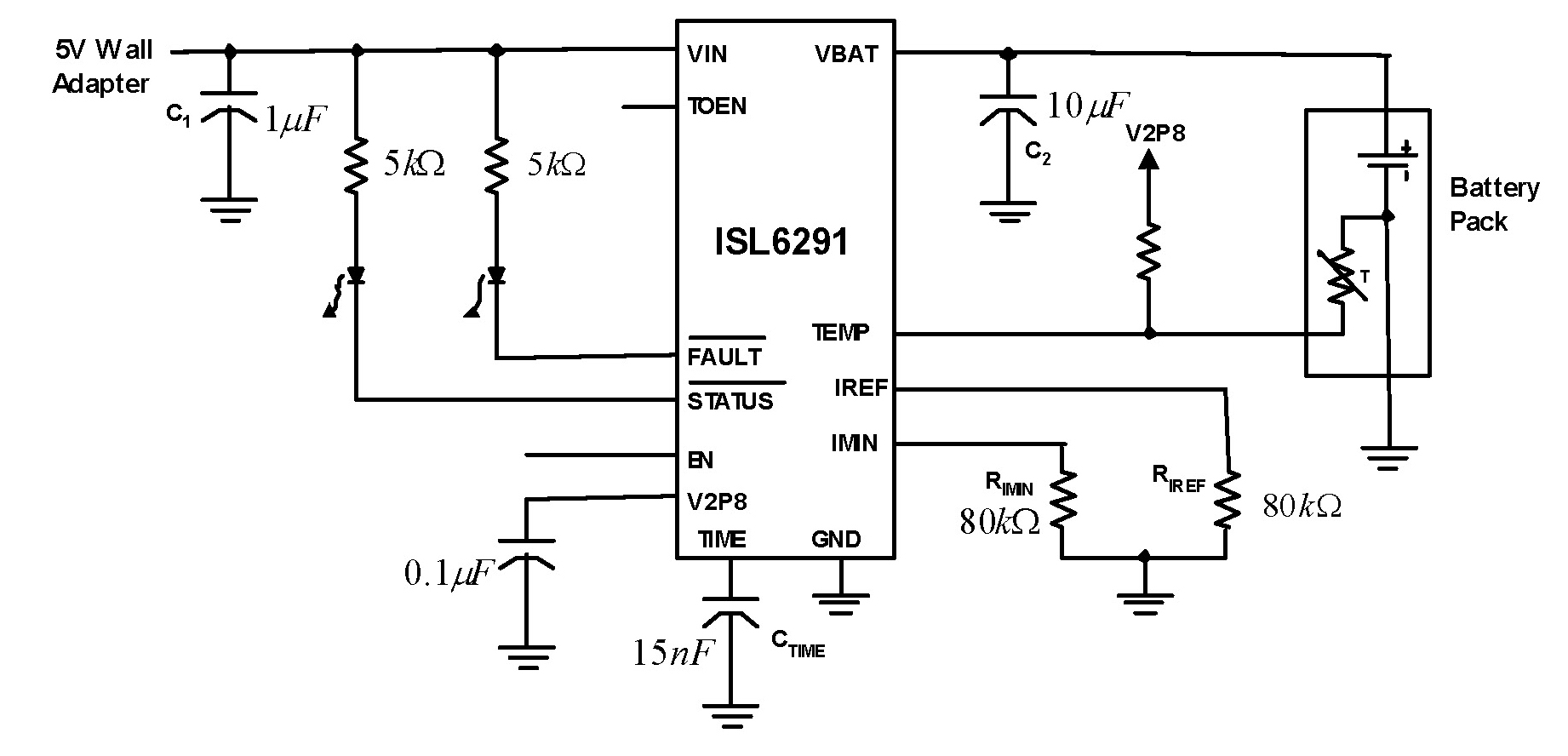
A Battery Powered Burglar Alarm With A Timed Siren Cut-Off
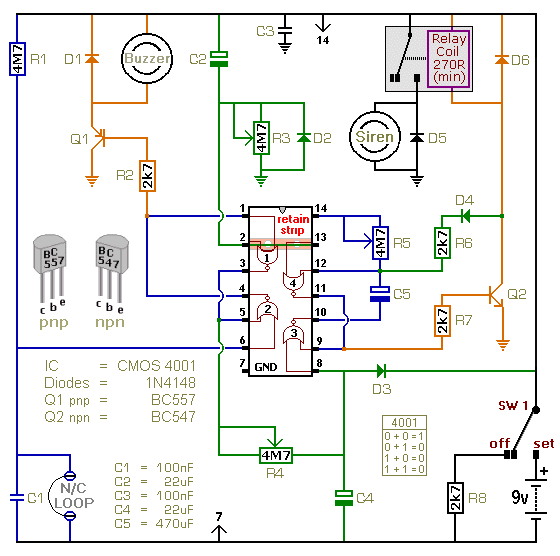
This is a single-zone alarm system featuring independently adjustable Exit, Entry, and Siren Cut-Off timers. It is compatible with standard normally-closed input devices such as magnetic-reed contacts, foil tape, and passive infrared sensors (PIRs). A mains power supply can be used; however, the exceptionally low standby current makes battery operation a viable option. A 9-volt supply is illustrated in the schematic, but the circuit can function with voltages ranging from 5 to 15 volts. The selection of a Siren, Buzzer, and Relay should correspond with the operating voltage. The alarm system is user-friendly, utilizing a two-way switch (Sw1). If the Buzzer activates when the alarm is turned on, it indicates that the normally-closed loop is open. Turning the alarm off allows for checking the premises for any open doors or windows. If the Buzzer remains silent, the loop is intact. Depending on the setting of resistor R3, there is a delay of up to approximately one minute to exit the building, during which the Buzzer will sound. Closing the door should stop the Buzzer, confirming that the loop has been restored within the allowed time. Upon returning and opening the door, the Buzzer will sound again. Based on the setting of R4, there is a delay of up to about one minute to turn off the alarm; failure to do so will trigger the Siren. The Siren will sound for a duration of up to 20 minutes, determined by the setting of R5, after which it will turn off and remain silent. The alarm can be silenced at any time by switching Sw1 to the "off" position. Precise timing is not critical for this device, and fixed resistors can replace the variable pots. For instance, using 2.2M ohm resistors can yield exit and entry delays of approximately 30 seconds and a Siren cut-off time of about 10 minutes. After the Siren cut-off timer has deactivated the Siren, the Buzzer will continue to sound, indicating that the alarm has been triggered upon return. Support materials for this alarm include a prototype photograph, a parts list, a detailed circuit description, and a step-by-step construction guide.
This single-zone alarm system is designed to provide effective security for residential or small commercial applications. The use of normally-closed input devices ensures that any breach in security will trigger the alarm, providing immediate notification of unauthorized access. The adjustable timers for Exit, Entry, and Siren Cut-Off enhance the system's flexibility, allowing users to customize the operation according to their specific needs.
The circuit's design incorporates a microcontroller or timer IC that manages the timing functions, ensuring accurate delays for each phase of the alarm operation. The use of a two-way switch (Sw1) simplifies the user interface, enabling easy activation and deactivation of the system. The feedback provided by the Buzzer serves as an immediate indicator of system status, allowing users to ascertain whether the alarm is armed and whether the loop is intact.
The power supply options enhance the versatility of the alarm system, allowing for installation in locations where mains power may not be readily available. The low standby current ensures that battery operation is practical, extending the operational life of the system without frequent battery replacements.
In terms of construction, the inclusion of a detailed parts list and step-by-step guide facilitates ease of assembly, making this alarm system accessible to both novice and experienced builders. The option to use fixed resistors instead of variable pots allows for further simplification of the design, catering to users who may prefer a more straightforward setup.
Overall, this single-zone alarm system provides a robust and customizable solution for enhancing security, with the added benefit of user-friendly operation and flexible power options.This is a single zone alarm - with independently adjustable Exit, Entry and Siren Cut-Off timers. It will accommodate the usual types of normally-closed input devices - such as magnetic-reed contacts, foil tape and PIRs. If you wish - you can use a mains power supply. But the extremely low standby current makes battery power a realistic option. I` ve used a 9-volt supply in the drawing - but the circuit will work at anything from 5 to 15-volts. All you need do is select a Siren, Buzzer, and Relay to suit the voltage you`re using. The alarm is easy to operate. Sw1 can be any type of two-way switch. If the Buzzer sounds when you switch the alarm on - the normally-closed loop is open. Switch off again - and check the building for open doors or windows. If the Buzzer does not sound - the loop is intact. Depending on the setting of R3 - you have up to about a minute to leave the building. As you do so - the Buzzer will sound. When you close the door behind you - it should stop sounding. This confirms that the loop has been restored within the time allowed. When you return and open the door - the Buzzer will sound. Depending on the setting of R4 - you have up to about a minute to switch the alarm off. If you fail to do so - the Siren will sound. Depending on the setting of R5 - the Siren will sound for up to about 20-minutes. Then it will switch off - and remain off. Of course - you can stop the noise at any time by moving Sw1 to the "off" position. For this type of device - really precise times are not necessary. If you like - you can replace the pots with fixed resistors. For example - 2M2 resistors should give you exit and entry delays of about 30-seconds - and a Siren cut-off time of about 10-minutes. After the cut-off timer has switched the Siren off - the Buzzer will continue to sound. So when you return - if the Buzzer is sounding - you`ll know that the alarm has been activated. The Support Material for this alarm includes a photograph of the prototype - a parts list - a detailed circuit description - a step-by-step guide to construction - and more.
🔗 External reference
This single-zone alarm system is designed to provide effective security for residential or small commercial applications. The use of normally-closed input devices ensures that any breach in security will trigger the alarm, providing immediate notification of unauthorized access. The adjustable timers for Exit, Entry, and Siren Cut-Off enhance the system's flexibility, allowing users to customize the operation according to their specific needs.
The circuit's design incorporates a microcontroller or timer IC that manages the timing functions, ensuring accurate delays for each phase of the alarm operation. The use of a two-way switch (Sw1) simplifies the user interface, enabling easy activation and deactivation of the system. The feedback provided by the Buzzer serves as an immediate indicator of system status, allowing users to ascertain whether the alarm is armed and whether the loop is intact.
The power supply options enhance the versatility of the alarm system, allowing for installation in locations where mains power may not be readily available. The low standby current ensures that battery operation is practical, extending the operational life of the system without frequent battery replacements.
In terms of construction, the inclusion of a detailed parts list and step-by-step guide facilitates ease of assembly, making this alarm system accessible to both novice and experienced builders. The option to use fixed resistors instead of variable pots allows for further simplification of the design, catering to users who may prefer a more straightforward setup.
Overall, this single-zone alarm system provides a robust and customizable solution for enhancing security, with the added benefit of user-friendly operation and flexible power options.This is a single zone alarm - with independently adjustable Exit, Entry and Siren Cut-Off timers. It will accommodate the usual types of normally-closed input devices - such as magnetic-reed contacts, foil tape and PIRs. If you wish - you can use a mains power supply. But the extremely low standby current makes battery power a realistic option. I` ve used a 9-volt supply in the drawing - but the circuit will work at anything from 5 to 15-volts. All you need do is select a Siren, Buzzer, and Relay to suit the voltage you`re using. The alarm is easy to operate. Sw1 can be any type of two-way switch. If the Buzzer sounds when you switch the alarm on - the normally-closed loop is open. Switch off again - and check the building for open doors or windows. If the Buzzer does not sound - the loop is intact. Depending on the setting of R3 - you have up to about a minute to leave the building. As you do so - the Buzzer will sound. When you close the door behind you - it should stop sounding. This confirms that the loop has been restored within the time allowed. When you return and open the door - the Buzzer will sound. Depending on the setting of R4 - you have up to about a minute to switch the alarm off. If you fail to do so - the Siren will sound. Depending on the setting of R5 - the Siren will sound for up to about 20-minutes. Then it will switch off - and remain off. Of course - you can stop the noise at any time by moving Sw1 to the "off" position. For this type of device - really precise times are not necessary. If you like - you can replace the pots with fixed resistors. For example - 2M2 resistors should give you exit and entry delays of about 30-seconds - and a Siren cut-off time of about 10-minutes. After the cut-off timer has switched the Siren off - the Buzzer will continue to sound. So when you return - if the Buzzer is sounding - you`ll know that the alarm has been activated. The Support Material for this alarm includes a photograph of the prototype - a parts list - a detailed circuit description - a step-by-step guide to construction - and more.
🔗 External reference
